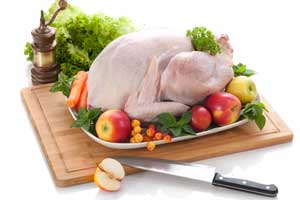Home »
Blog »
Low-Fat Thanksgiving Turkey
Low-Fat Thanksgiving Turkey
Posted on Nov 14, 2014 by Guest Writer
Thanksgiving is traditionally a time when we reflect on the things we are thankful for, and indulge ourselves in celebration of the bounty we received during the year. In fact, many of our popular Thanksgiving foods are
deeply rooted in tradition, and while they might not always be the healthiest options, they are comforting and remind us of home. Additionally, different regions add their own twist. For example, my Southern relatives always include ham and spoon bread on the Thanksgiving table; my Eastern in-laws always have mashed potatoes and carmelized onions. Regardless of your sides, the turkey is the one constant. It’s the centerpiece of the table, and the most important part of the meal. Unfortunately, it’s often the part that’s easiest to mess up.

Turkeys don’t have a lot of fat, and you have to cook them a long time, which makes it easy to dry them out. You can add a lot of butter and oils, but that also increases the calories and fat. Below is one of the many
Thanksgiving recipes for a tasty and succulent bird. Remember, we're aiming for low-fat.
Supplies
-
Paper towels
-
Baking sheet
-
One large Roasting Pan
-
One roasting rack for the pan*
-
Aluminum foil
-
One cooking brush
-
One turkey baster
-
One meat thermometer
Ingredients
-
1 whole turkey (12-14 lbs) completely thawed
-
1 medium onion
-
1 lemon
-
2 tbsp extra virgin olive oil
-
6 sprigs each rosemary, sage, and thyme
-
1 tsp salt
-
Black pepper
Preparation
The Night Before
Clean the turkey by removing giblet bag from the cavity, and rinsing the inside and outside with cold water. Pat any excess moisture from the inside and outside of the turkey, with paper towels. Wrap the turkey in plastic wrap and place it in the refrigerator until the next day.
The Day Of
-
Preheat your oven to 450 degrees Fahrenheit and place the rack in the lower position.
-
Pat the turkey inside and out with paper towels to remove any moisture that has collected overnight.
-
Place rack inside the roasting pan, and put the turkey on the rack, breast-side up. If you do not have a rack, you can make a “Snake” out of aluminum foil to serve as a rack. You can also use root vegetables like potatoes, parsnips, carrots and onions in place of the foil or the rack.
-
Cut the potatoes and onions in half, and then cut off the rounded part so that the turkey has a stable surface to rest on. Make sure all the pieces are approximately the same height.
-
Cut carrots and parsnips into little pillars of approximately the same height, and let the turkey rest on top of them.
-
Cut the lemon in half, and peel the onion and cut it into quarters. Stuff one lemon half, all of the onion, and four sprigs each of the rosemary, sage, and thyme into the cavity.
-
Squeeze the remaining lemon half into a small bowl with the olive oil, the tsp of salt, and the pepper to your taste. Brush the lemon and olive oil mixture all over the turkey.
-
Place the turkey, uncovered, into the 450-degree oven for 15 minutes. The high heat will sear the outside of the turkey and seal in the juices.
-
After 15 minutes, reduce the heat to 325 degrees, cover the turkey with foil (or put the cover on the roasting pan) and let it roast for 15 minutes per pound (for a 14 pound turkey that’s approximately 210 minutes, or 3.5 hours), or until the temperature in the thickest part of the thigh reaches 180 degrees.
-
Let the turkey roast unmolested for two hours, then baste the turkey or brush it with juices at ten to fifteen minute intervals during the last hour and a half.
-
In the last half hour, remove the foil to let the skin crisp up.
-
Remove the turkey from the oven and let it rest for at least 15 minutes before serving. If you are transporting the turkey to another location, remove it from the oven and box it up roaster and all just before you leave for your destination.
Tips and Tricks
-
You want to make sure the turkey has completely thawed before you start cooking it. A frozen turkey can take three or four days to thaw in the refrigerator. Do not thaw the turkey outside the refrigerator.
-
Repeatedly opening the oven can lower the oven temperature and dry out the bird. This is why you should leave the bird alone for most of the cook time, and only baste it near the end.
-
You can add garlic to this recipe, however Anthony Bourdain recommends against it in very strong terms.



0 Comments